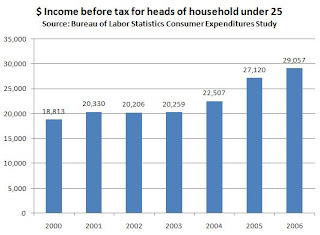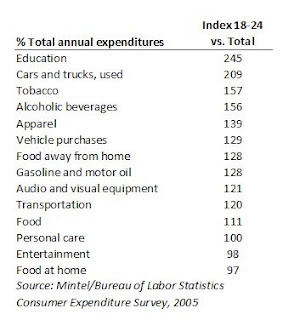
I am losing patience with the pronouncements that this is the first generation that expects to be downwardly mobile. The reality is that 18-24 year olds are among the wealthiest people in America. Just don’t tell them that, they won’t believe it.
According to the Bureau of Labor Statistics, 87.3 percent of 18- to 24-year-old males had wages and salary in 2005. In 2006, households headed by persons 18 to 24 had earnings before taxes of nearly $29,057, up from just $20,120 in 2003 and up 7.5 percent 2005-2006 alone. For comparison, U.S. income grew just 1.1 percent in the same period. What makes these figures even more astonishing is that 18 to 24 year olds by and large do not have families to support. According to the National Center for Education Statistics, 43 percent of 18 to 24 year olds are college students. Less than 10 percent of 18- to 24-year-old males are married. Fifty percent of 18- to 24-year-old men live with their parents, and 33 percent of women live with the parents.
If you think starting salaries are down, you’d be wrong. According to Businessweek, the expected starting salaries of new MBAs exceeds $85,000, up steadily every year but one since 2002. Starting salaries offered to undergrad business administration majors increased 7.5 percent in one year.
So why the angst? Why do most 18-24 year olds consider themselves poor now and their prospects even poorer?

My personal theory is that Millennials have a different idea of what constitutes a “necessity” and what constitutes a “luxury.” My college students consider themselves “poor,” yet nearly all sport iPods with thousands of songs, the latest laptops, expensive footwear, cell phones with plans that cost $100 or more each month. The data bears this out. According to the BLS, 18- to 24-year-olds spend a disproportionate amount of money on virtually every category of spending other than food and housing (see table). Within these categories,they have luxury tastes. For example, Millennials are almost twice as likely as older consumers to purchase imported beers and almost three times as likely to pick up a craft beer.
Marketers are on to this insight, even if the Millennials themselves are not. Eighteen to 24-year-olds represent a vast market for ‘luxury’ goods — we just don’t call them luxuries.

